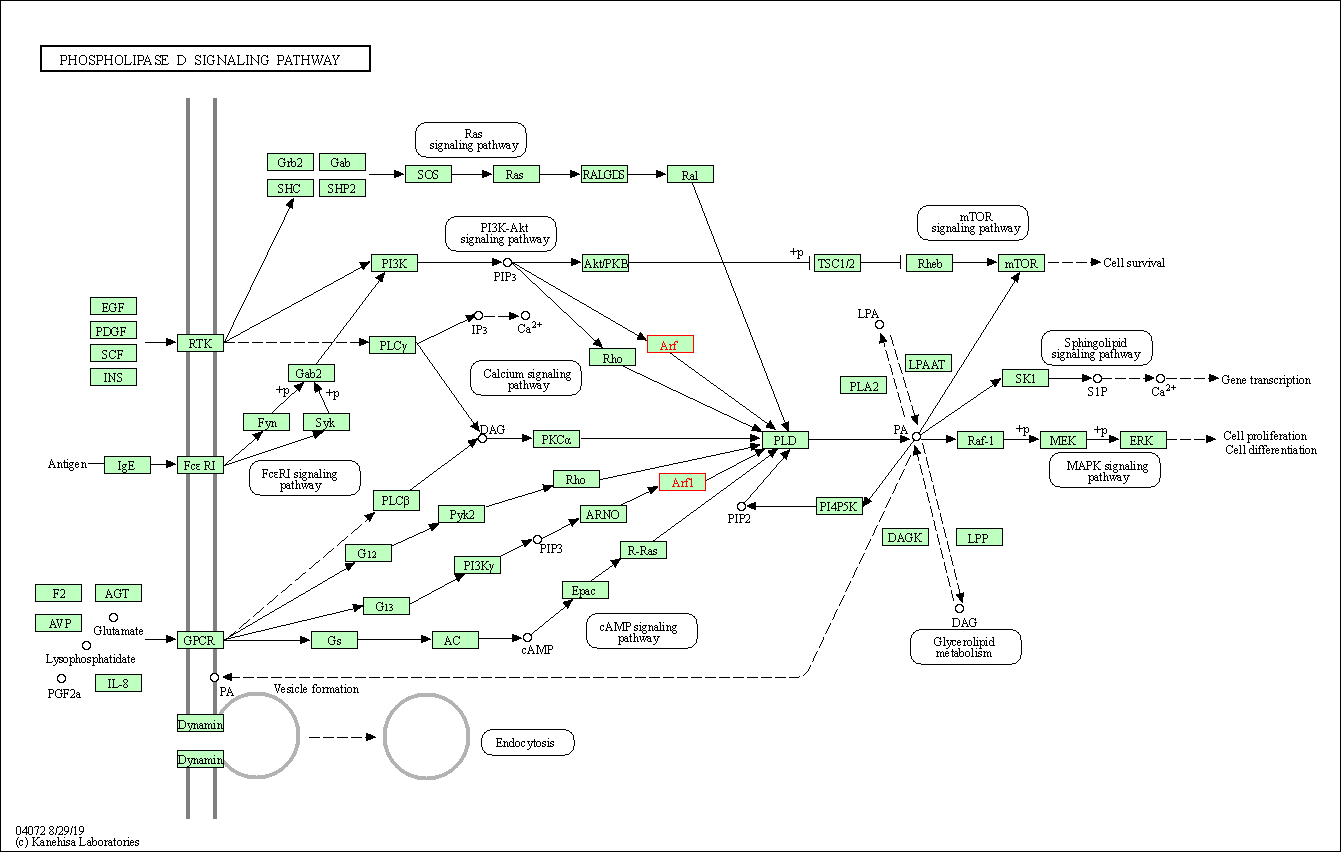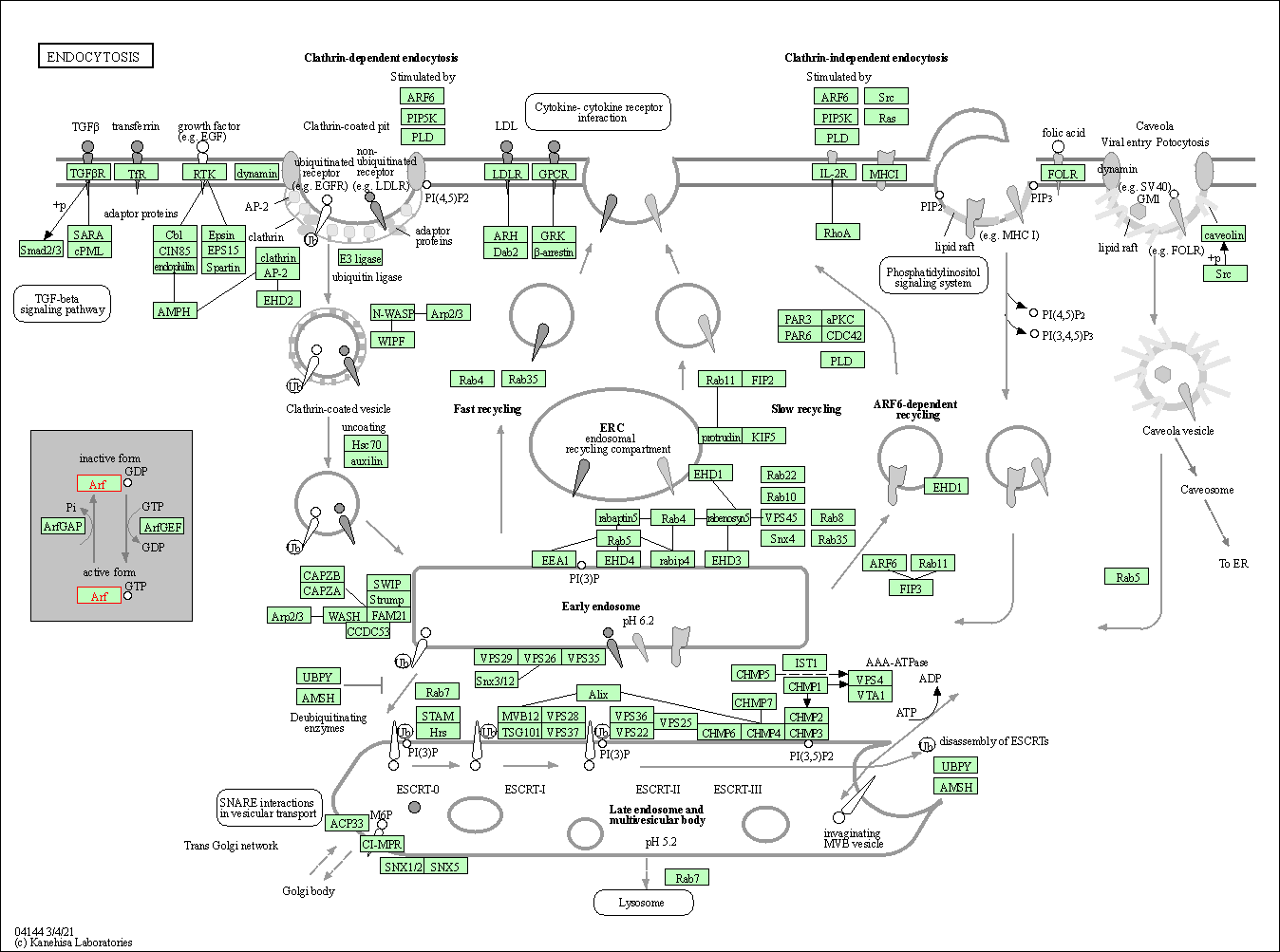Target Information
| Target General Information | Top | |||||
|---|---|---|---|---|---|---|
| Target ID |
T47351
(Former ID: TTDNR00636)
|
|||||
| Target Name |
ADP-ribosylation factor 1 (ARF1)
|
|||||
| Synonyms |
PVNH8
Click to Show/Hide
|
|||||
| Gene Name |
ARF1
|
|||||
| Target Type |
Literature-reported target
|
[1] | ||||
| Function |
Modulates vesicle budding and uncoating within the Golgi complex. Deactivation induces the redistribution of the entire Golgi complex to the endoplasmic reticulum, suggesting a crucial role in protein trafficking. In its GTP-bound form, its triggers the association with coat proteins with the Golgi membrane. The hydrolysis of ARF1-bound GTP, which is mediated by ARFGAPs proteins, is required for dissociation of coat proteins from Golgi membranes and vesicles. The GTP-bound form interacts with PICK1 to limit PICK1-mediated inhibition of Arp2/3 complex activity; the function is linked to AMPA receptor (AMPAR) trafficking, regulation of synaptic plasicity of excitatory synapses and spine shrinkage during long-term depression (LTD). GTP-binding protein involved in protein trafficking among different compartments.
Click to Show/Hide
|
|||||
| BioChemical Class |
Small GTPase
|
|||||
| UniProt ID | ||||||
| Sequence |
MGNIFANLFKGLFGKKEMRILMVGLDAAGKTTILYKLKLGEIVTTIPTIGFNVETVEYKN
ISFTVWDVGGQDKIRPLWRHYFQNTQGLIFVVDSNDRERVNEAREELMRMLAEDELRDAV LLVFANKQDLPNAMNAAEITDKLGLHSLRHRNWYIQATCATSGDGLYEGLDWLSNQLRNQ K Click to Show/Hide
|
|||||
| 3D Structure | Click to Show 3D Structure of This Target | PDB | ||||
| HIT2.0 ID | T78M0B | |||||
| Cell-based Target Expression Variations | Top | |||||
|---|---|---|---|---|---|---|
| Cell-based Target Expression Variations | ||||||
| Drug Binding Sites of Target | Top | |||||
|---|---|---|---|---|---|---|
| Ligand Name: Guanosine-5'-Diphosphate | Ligand Info | |||||
| Structure Description | HUMAN ADP-RIBOSYLATION FACTOR 1 COMPLEXED WITH GDP, FULL LENGTH NON-MYRISTOYLATED | PDB:1HUR | ||||
| Method | X-ray diffraction | Resolution | 2.00 Å | Mutation | No | [2] |
| PDB Sequence |
GNIFANLFKG
11 LFGKKEMRIL21 MVGLDAAGKT31 TILYKLKLGE41 IVTTIPTIGF51 NVETVEYKNI 61 SFTVWDVGGQ71 DKIRPLWRHY81 FQNTQGLIFV91 VDSNDRERVN101 EAREELMRML 111 AEDELRDAVL121 LVFANKQDLP131 NAMNAAEITD141 KLGLHSLRHR151 NWYIQATCAT 161 SGDGLYEGLD171 WLSNQLRNQK181
|
|||||
|
|
||||||
| Click to View More Binding Site Information of This Target and Ligand Pair | ||||||
| Ligand Name: Guanosine-5'-Triphosphate | Ligand Info | |||||
| Structure Description | phospho-STING binding to adaptor protein complex-1 | PDB:7R4H | ||||
| Method | Electron microscopy | Resolution | 2.34 Å | Mutation | Yes | [3] |
| PDB Sequence |
EMRILMVGLD
26 AAGKTTILYK36 LKLGEIVTTI46 PTIGFNVETV56 EYKNISFTVW66 DVGGLDKIRP 76 LWRHYFQNTQ86 GLIFVVDSND96 RERVNEAREE106 LMRMLAEDEL116 RDAVLLVFAN 126 KQDLPNAMNA136 AEITDKLGLH146 SLRHRNWYIQ156 ATCATSGDGL166 YEGLDWLSNQ 176 LRNQK
|
|||||
|
|
LEU25
3.230
ASP26
3.357
ALA27
2.712
ALA28
3.621
GLY29
2.197
LYS30
1.300
THR31
2.885
THR32
3.761
ILE42
3.488
THR45
3.395
ILE46
3.995
PRO47
3.479
|
|||||
| Click to View More Binding Site Information of This Target with Different Ligands | ||||||
| Different Human System Profiles of Target | Top |
|---|---|
|
Human Similarity Proteins
of target is determined by comparing the sequence similarity of all human proteins with the target based on BLAST. The similarity proteins for a target are defined as the proteins with E-value < 0.005 and outside the protein families of the target.
A target that has fewer human similarity proteins outside its family is commonly regarded to possess a greater capacity to avoid undesired interactions and thus increase the possibility of finding successful drugs
(Brief Bioinform, 21: 649-662, 2020).
Human Pathway Affiliation
of target is determined by the life-essential pathways provided on KEGG database. The target-affiliated pathways were defined based on the following two criteria (a) the pathways of the studied target should be life-essential for both healthy individuals and patients, and (b) the studied target should occupy an upstream position in the pathways and therefore had the ability to regulate biological function.
Targets involved in a fewer pathways have greater likelihood to be successfully developed, while those associated with more human pathways increase the chance of undesirable interferences with other human processes
(Pharmacol Rev, 58: 259-279, 2006).
Biological Network Descriptors
of target is determined based on a human protein-protein interactions (PPI) network consisting of 9,309 proteins and 52,713 PPIs, which were with a high confidence score of ≥ 0.95 collected from STRING database.
The network properties of targets based on protein-protein interactions (PPIs) have been widely adopted for the assessment of target’s druggability. Proteins with high node degree tend to have a high impact on network function through multiple interactions, while proteins with high betweenness centrality are regarded to be central for communication in interaction networks and regulate the flow of signaling information
(Front Pharmacol, 9, 1245, 2018;
Curr Opin Struct Biol. 44:134-142, 2017).
Human Similarity Proteins
Human Pathway Affiliation
Biological Network Descriptors
|
|
| KEGG Pathway | Pathway ID | Affiliated Target | Pathway Map |
|---|---|---|---|
| Phospholipase D signaling pathway | hsa04072 | Affiliated Target |

|
| Class: Environmental Information Processing => Signal transduction | Pathway Hierarchy | ||
| Endocytosis | hsa04144 | Affiliated Target |

|
| Class: Cellular Processes => Transport and catabolism | Pathway Hierarchy | ||
| Degree | 30 | Degree centrality | 3.22E-03 | Betweenness centrality | 3.81E-03 |
|---|---|---|---|---|---|
| Closeness centrality | 2.06E-01 | Radiality | 1.36E+01 | Clustering coefficient | 2.53E-02 |
| Neighborhood connectivity | 5.73E+00 | Topological coefficient | 5.10E-02 | Eccentricity | 12 |
| Download | Click to Download the Full PPI Network of This Target | ||||
| Target Regulators | Top | |||||
|---|---|---|---|---|---|---|
| Target-interacting Proteins | ||||||
| References | Top | |||||
|---|---|---|---|---|---|---|
| REF 1 | Suppression of breast cancer metastasis through the inactivation of ADP-ribosylation factor 1. Oncotarget. 2016 Sep 6;7(36):58111-58120. | |||||
| REF 2 | Structure of the human ADP-ribosylation factor 1 complexed with GDP. Nature. 1994 Dec 15;372(6507):704-8. | |||||
| REF 3 | Clathrin-associated AP-1 controls termination of STING signalling. Nature. 2022 Oct;610(7933):761-767. | |||||
If You Find Any Error in Data or Bug in Web Service, Please Kindly Report It to Dr. Zhou and Dr. Zhang.

